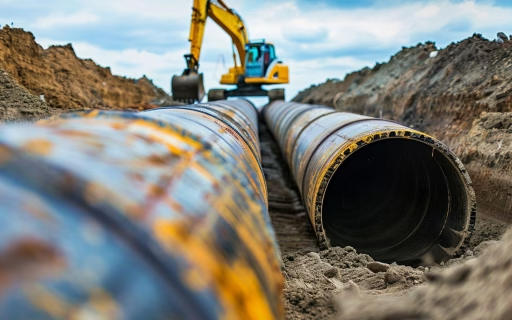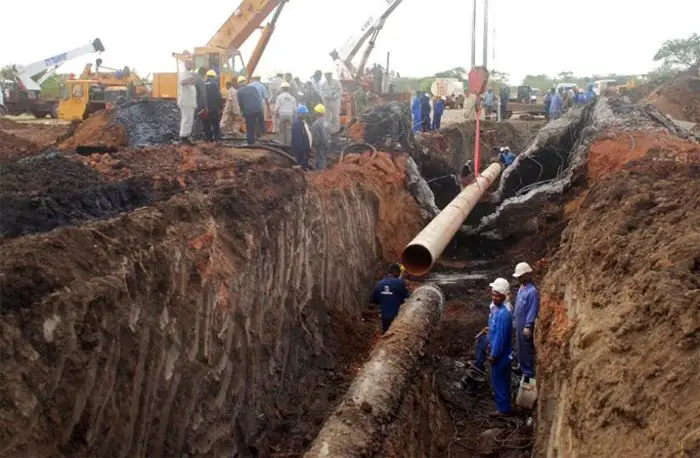The proposed Kenya-Uganda Crude Oil Pipeline was intended to transport crude oil from Uganda’s fields through Kenya’s Turkana region to a new port in Lamu. However, the project was abandoned in 2016 when Uganda chose the rival route through Tanzania. This decision, influenced by factors like security concerns over the Lamu route, cost considerations, and easier land acquisition in Tanzania, led to the development of the East African Crude Oil Pipeline (EACOP), a 1,443 km heated pipeline from Uganda’s Hoima district to the Tanzanian port of Tanga.
While the Uganda-Kenya crude pipeline was shelved, a separate project for a refined petroleum products pipeline extension from Eldoret, Kenya, to Kampala, Uganda, continues to be pursued to improve regional fuel supply logistics, indicating a selective continuity of energy cooperation despite the significant loss of the crude oil transit opportunity for Kenya.
In a related development project, Kenya has given a green light on South Lokichar Basin Field Development. This is a significant milestone in Kenya’s journey to becoming an oil producer in the region. Once the development is fully executed, the project will be a major boost to Kenya’s economy.

July 28, 2024
Kenya and Uganda have opened talks on the extension of the petroleum pipeline to Kampala, a major infrastructure development that will shape the region’s fuel imports market.. The Uganda-Kenya Oil Pipeline was a joint project proposed in 2014 to build a crude oil pipeline between Kenya and Uganda. The project was planned to enable the two East African neighbors to share construction costs and revenues generated by crude exports.
This comes in the wake of own fuel importation by Uganda, which commenced in early July, ending an era of Kenya-controlled importation and supply of refined products for the landlocked country.
The neighbouring country is importing oil products through a deal between the Uganda National Oil Corporation (Unoc) and Vitol Bahrain.
This is similar arrangement to Kenya’s government-to-government deal with the Gulf oil majors, with Kampala hoping to lower pump prices below what was being offered by dealers in Kenya.
It however continues to use Kenya’s Port of Mombasa (New Kipevu Oil Terminal) and Kenya Pipeline Company (KPC)’s infrastructure to have its products delivered to the Eldoret depot, before last mile delivery by road.
Uganda Plans for the Pipeline
Uganda’s Energy minister Ruth Nankabirwa is leading a delegation in the early planning stages, with the first meeting held in Nairobi this week.
“I am in Kenya to start the planning and preparation for the proposed Eldoret-Kampala-Kigali pipeline,” Nankabirwa said yesterday, noting the Nairobi working trip also involved understanding Kenya Pipeline’s operations, infrastructure and human capacity.

On Tuesday, she chaired a bilateral meeting with Kenya’s Petroleum PS Mohamed Liban together with KPC managing director Joe Sang, among other top Kenya Pipeline managers, where they reviewed the proposed Eldoret Kampala Refined Petroleum Products Pipeline.
Unfortunately, the Uganda-Kenya Oil Pipeline project never went beyond the conceptual paperwork stage. Uganda eventually dropped the proposal in 2016 and accepted a more competitive counteroffer from Tanzania. According to Uganda’s government, using Kenya’s port of Lamu was more expensive than Tanzania’s Tanga port.
Also Read Construction of Keystone XL Pipeline in the United Sates to begin
Uganda’s decision to drop the Uganda-Kenya Oil Pipeline led to the development of the famous 1440-kilometer East African Crude Oil Pipeline. Kenya was forced to work on plans to build a KSh121.45 billion pipeline from Lokichar to its port, which is currently under construction in Lamu.
Reported in October 2014
IFC pledges US$600m for an East Africa regional oil pipeline
The International Finance Corporation (IFC), a lending arm of the World Bank, has pledged US$ 600m to fund an oil pipeline in East Africa. The funding is part of a US$1.8bn loan for projects in the Horn of Africa.
The oil pipeline is expected to link up upstream operations in Kenya, Uganda, and South Sudan. A statement by the bank indicates that the investments will aid the expansion of agribusiness, processing, and seeds.
The whole project has been estimated to cost US$5bn. The current pipeline in Kenya reaches Eldoret where a new 350-kilometer pipeline will be constructed at a cost of US$302m up to Kampala, Uganda. Another 434-kilometer pipeline will then be built from Kampala to Kigali, Rwanda.
Significance of the Project
The move to construct the oil pipeline is aimed at enabling crude exports in the region and boosting its oil industry. It will also end the dependence of South Sudan on Sudan for its oil exports. A tender for the new pipeline was advertised last month, calling for both international and local experience, but the contractor is yet to be selected.
The development of the pipeline is welcomed in the region especially after Kenya and Uganda discovered commercially viable oil deposits. The pipeline will eradicate the current tanker transportation need and subsequently reduce the price of oil for consumers.
Chatham House, a source of independent analysis, indicates in a report, that the region has an opportunity to use the newfound oil and gas resources to enhance regional development and integration. Leaders are thus urged to show vision and foresight, in using these resources to enhance regional infrastructure, reduce poverty and invest in education, and create diversified, globally competitive economies.
Earlier in May this year, the government had said that Kenya’s pipeline would be extended to Uganda and South Sudan. In June last year, Kenya, Uganda, and Rwanda had agreed on a strategy to fund oil pipeline construction linking themselves for regional cooperation motives.
Reported in November 2014
Consultant for the US$4bn East Africa oil pipeline revealed
Kenya, Uganda, and Rwanda have concluded the search for a consultant for the regional oil pipeline. The project will be developed as a single project, split into sections that will be carried out by each state in their regions according to Kenya’s Energy PS Joseph Njoroge.
The three states settled on Toyota Tsusho Engineering Corporation where a deal was signed on Thursday in Kampala, Uganda. The company was selected among eight that had prequalified for the tender. It is expected that feasibility studies and design of the pipeline will be carried out by the company in five months, from the period of issuance of the contract.
Toyota will also be required to supervise the construction of a fiber optic cable running from Hoima in Uganda, through Lokichar in Kenya to Lamu, and tank terminals in Hoima, Lokichar, and Lamu. Tullow Oil and Africa Oil have in the recent past discovered 600 million barrels of commercially viable oil in the South Lokichar basin in Kenya and thus the need for the multi-billion dollar project. In Uganda, the government estimates their crude reserves at 6.5 billion barrels.
Kenya, Uganda, and Rwanda embarked on the construction of the USD 4bn Hoima-Lokichar-Lamu crude oil pipeline project.
The idea of a single contractor for the project was approved by the East African Community member states of Uganda, Rwanda, South Sudan, Tanzania, and Burundi in May this year. The International Finance Corporation has already committed to providing US$600m for the pipeline project.
Reported in December 2014
Feasibility study for Kenya-Uganda oil pipeline to take 5 months
The Principal Secretary to the Energy and Petroleum Ministry Joseph Njoroge has said that a feasibility study for Kenya – Uganda oil pipeline will be expected by mid-April next year. The contract will be undertaken by Toyota Tsusho, a Japanese carmaker, which won the tender last month.
The pipeline will run from Lamu-Kenya to Hoima-Uganda, passing through the Lokichar basin. The company is also expected to come up with the design for the crude oil pipeline that will cover a distance of 1, 300 km. Also alongside the task will be the company’s supervision of the construction of tank terminals in Hima, Lamu, and Lokichar, as well as the construction of a fiber optic cable from Lamu to Hoima through Lokichar.
Expected to take up US$4.4 billion, the project will help in harnessing crude oil from the Rift Valley basin – estimated at 1 billion barrels, and the Uganda crude reserves estimated to be 6.5 billion barrels. Also to be constructed is a 9-km pipeline running from the Lamu tank terminal to a loading buoy anchored offshore.
Early last month, the government awarded the tender for the project, and International Finance Corporation pledged to offer US$600m for the oil pipeline project.
Sep 2015
Tender for the construction of the Kenya-Uganda pipeline to be announced
A tender for the construction of the US$ 4bn Kenya-Uganda pipeline that is expected to cover 1,500km is set to be announced before the end of this year. The construction project has been incorporated into the Lamu Port- South Sudan-Ethiopia Transport Corridor (Lapsset) infrastructure project.
The Lapsset Corridor Development Authority (LCDA) confirmed the reports and said that the tender that will be inviting companies to submit bids to put up the crude oil pipeline will be announced before the end of this year so as to pave way for the construction works which are projected to commence in early 2016.
LCDA Director-General Silvester Kasuku said that funds that will be used in the construction of the Kenya-Uganda pipeline will come from debt and equity.
“The selection of a transaction advisor is almost complete and the first oil is expected to flow in 2019. The pipeline is a critical success factor of Lapsset, which will open about 70 percent of Kenya’s landmass towards economic development,” Mr. Kasuku said.
The pipeline which is expected to cover about 1,500km from Hoima in western Uganda to the Lamu port on Kenya’s Coast will be beneficial to the two countries as it will enable them to export crude oil.
It was anticipated that the Kenya-Uganda pipeline will be complete either in 2018 or 2019.
Lapsset projects include the Lamu port, standard gauge railway, roads, refined products pipeline, airports, resort cities, and the crude oil refinery in Lamu.
Reported in March 2016
Kenya to bear the burden of constructing the proposed crude oil pipeline
Since Uganda and Tanzania backed out on the proposed crude oil pipeline construction at the Coast, Kenya is being faced with the burdensome job of constructing the pipeline alone.
Uganda and Tanzania agreed to build a similar facility at Tanga port while South Sudan is thinking of an alternative route via Ethiopia to Djibouti instead of South Lokichar in northern Kenya through Isiolo to Lamu on the Indian Ocean.
Kenya has so far discovered 600 million barrels of crude oil in South Lokichar while Uganda has found 6.5 billion barrels of oil. A joint pipeline was to be developed from Hoima in western Uganda through Lokichar to Kenya’s Coast to enable the two countries to commence the export of oil.
This initiative would have fed on the vast resource from the famous Jonglei state in South Sudan, industry analysts place it at double the combined offtake from Kenya and Uganda hence increasing its viability.
South Sudan to be a Part of the Project
“The Lokichar-Lamu pipeline would still be viable with South Sudan on board or if more exploitable reservoirs were discovered in Northern Kenya,” said Patrick Obath, the managing consultant of Eduardo Associates, a sector analyst.
The competitor projects have complained of fears of over-investment in this industry of oil transport infrastructure given the limited nature of the discovery, despite hopes that continuing explorations will give in more.
Tanzania’s President John Magufuli and Uganda’s Yoweri Museveni’s made the announcement to build the southern route pipeline from Hoima in the Albertine basin through northern Tanzania to Tanga port of the agreement during the East African Community Heads of States Summit held in Arusha
“We did not receive any communiqué from either Tanzania or Uganda. Kenya and Uganda have signed a memorandum of understanding (MoU) to construct the Northern Corridor route pipeline after doing away with the central crude oil pipeline from Hoima through Kampala to Mombasa port,” said senior government officials from Kenya’s Energy Ministry.

